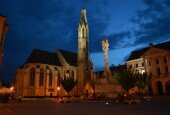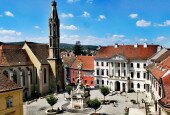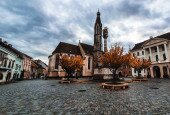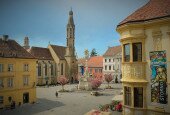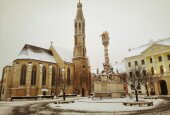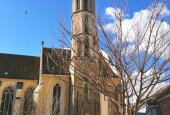Benedictine (Goat) church and Chapter Hall
In the heart of the town centre, on the Main Square you can find one of the most famous and oldest churches in the historic centre, the Goat Church.
The origins of the church date back to the 13th century and can be attributed to the Franciscan monks who began building the Gothic church and their cloister in the 1260s.
It was rebuilt around the turn of the 14th and 15th centuries on behalf of the Geissel family, the church tower with the family coat of arms was completed at that time. Hence the name Goat church, to which the oral tradition linked a legend, but behind the name there is a murder case.
According to legend, the church was built of treasure found by a goat, but in reality, there is a murder case in the background. Henrik Geissel (Geissel means goat in English), the perpetrator of a murder or his family donated the money to build a church tower as penitence.
Another memory of the era is the Kapisztrán pulpit, on which János Kapisztrán was said to be preaching in 1455, encouraging the faithful to fight the Ottoman Turks.
In the 16th and 17th century, 5 parliament meetings were held within its walls. Ferdinand III and two Hungarian queens were also crowned here. Among other noble families, the Esterházys, the Széchényi family and the Meskó family chose this church as a family burial place.
The symbolic ornamentation of the consoles and keystones that hold the arches in the Chantry hall is unique in the Hungarian Gothic architecture. After the fire in Sopron in 1676, the Baroque reconstruction of the church began, which continued in the 18th century. In 1787 Joseph II disbanded the mendicant orders, so the Franciscans were forced to leave their convent as well and the church was out of use until 1802. Then it became the property of the Benedictines, who carried out several transformations and renovations under the direction of Ferenc Storno Sr.
Following its most recent renovation in 2011, a permanent interactive exhibition of cultural and architectural history was created in the building complex.
THE CHAPTER HALL IS NOT OPEN TO THE VISITORS.


